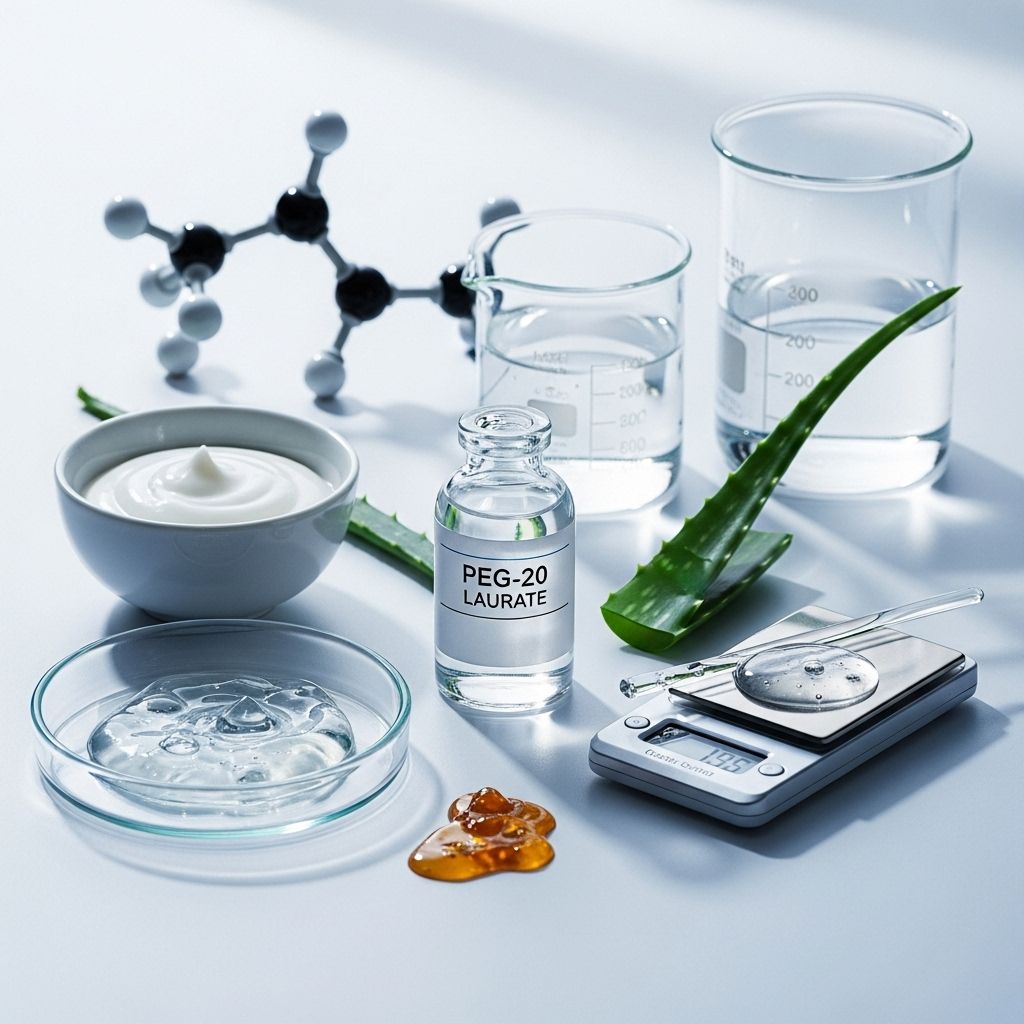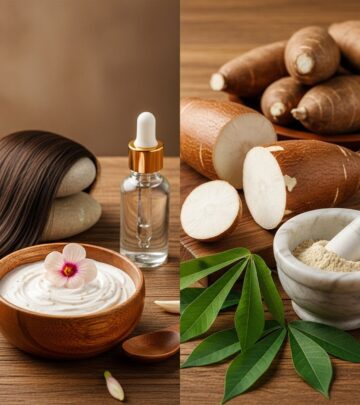PEG-20 Laurate: Properties, Uses, and Safety in Cosmetics
Explore the chemistry, functions, applications, and safety of PEG-20 Laurate and related ingredients in modern cosmetic and personal care products.

PEG-20 Laurate: An In-Depth Guide
PEG-20 Laurate is a widely used ingredient in personal care and cosmetic formulations. It belongs to the broader class of polyethylene glycol (PEG) esters of lauric acid, providing essential functions as a surfactant and emulsifier. Its unique chemical properties and high safety profile make it a staple in products ranging from shampoos and creams to facial cleansers. This article explores PEG-20 Laurate’s origins, chemical structure, functional roles, applications, and safety information, drawing on research, regulatory reviews, and industry practices.
What Is PEG-20 Laurate?
PEG-20 Laurate is part of a family known as PEG Dilaurates and PEG Laurates, which are polyethylene glycol esters of lauric acid—a naturally occurring fatty acid chiefly found in coconut oil and palm kernel oil. These compounds vary in the number of repeating ethylene glycol units (shown in the number after “PEG-“), which influences their solubility and physical appearance. PEG-20 Laurate itself is typically a pale yellow, oily liquid or a tan, waxy solid, used extensively in formulations for its ability to emulsify, solubilize, and cleanse.
- Main chemical groups: PEG Diesters (Dilaurates) and Monoesters (Laurates)
- Source of lauric acid: Coconut oil, palm kernel oil
- Physical form: Ranges from light liquids to waxy solids
- Common aliases: Polyethylene Glycol Laurate, PEG-20 Monolaurate
Chemical Structure and Origin
PEG-20 Laurate is synthesized through the reaction of polyethylene glycol (PEG) with lauric acid, creating ester bonds. The “20” denotes the average number of ethylene oxide units in the PEG chain, resulting in moderate solubility and favorable emulsifying properties. The lauric acid component, derived primarily from plant oils, is a saturated fatty acid with a 12-carbon chain.
| Chemical Component | Origin | Role in PEG-20 Laurate |
|---|---|---|
| Polyethylene glycol (PEG) | Synthetic (from ethylene oxide) | Hydrophilic (water-attracting) backbone |
| Lauric acid | Natural (mainly from coconut oil) | Hydrophobic (oil-attracting) tail |
The combination results in an amphiphilic molecule—one that can interact with both water and oil substances, an essential feature for surfactants and emulsifiers.
Functions in Cosmetics and Personal Care
PEG-20 Laurate performs several crucial functions in personal care and cosmetic products:
- Surfactant – Emulsifying Agent: Facilitates formation and stabilization of emulsions by lowering surface tension between oil and water phases.
- Surfactant – Cleansing Agent: Assists in mixing oil, dirt, and water, enabling removal during washing.
- Solubilizer: Increases the solubility of otherwise water-insoluble compounds, such as fragrances and active ingredients.
- Skin Conditioning Agent: Helps maintain skin in a soft, smooth, and healthy-looking condition.
Owing to these capabilities, PEG-20 Laurate is an enabling component in many product types, ensuring desirable texture, stability, performance, and user experience.
Common Applications
PEG-20 Laurate appears across a broad spectrum of products in the cosmetics and personal care sector:
- Shampoos
- Hair conditioners
- Face cleansers and toners
- Bath products (gels, soaps, bubble baths)
- Skin care and moisturizing creams
- Aftershaves
- Body washes and lotions
- Products combining oil, fragrance, and aqueous phases
In these applications, PEG-20 Laurate not only emulsifies and solubilizes, but can also influence viscosity, improve sensory properties, and improve rinsability.
Mechanism of Action
The effectiveness of PEG-20 Laurate hinges on its amphiphilic structure:
- The hydrophilic PEG chain interacts with water molecules.
- The hydrophobic laurate tail interacts with oils and lipophilic substances.
This dual interaction reduces surface tension at the oil-water interface, enabling the dispersion of oil droplets in water (emulsification) and the suspension of dirt and sebum for easy rinsing (cleansing). These features are common to all surfactants, but PEG-20 Laurate is prized for its mildness and compatibility with sensitive skin.
Related PEG Laurate and Dilaurate Ingredients
The PEG Laurate and PEG Dilaurate family consists of multiple compounds distinguished by their degree of polymerization (number of PEG units) and mono- or diester status:
- PEG-2, -4, -6, -8, -12, -20, -32, -75, -150 Dilaurate
- PEG-2, -4, -6, -8, -9, -10, -12, -14, -20, -32, -75, -150 Laurate
- PEG-2 Laurate SE (self-emulsifying, includes sodium or potassium laurate for improved functionality)
Each variant is selected based on the desired balance between hydrophilic and lipophilic character, impacting product behavior from foaming to rinsing and solubility.
| Ingredient Name | Main Use | Notable Features |
|---|---|---|
| PEG-20 Laurate | Emulsifier, surfactant | Balanced hydrophilic/lipophilic properties |
| PEG-20 Glyceryl Laurate | Emulsifier, moisturizer | Gentle, suitable for sensitive skin |
| PEG-2 Laurate SE | Self-emulsifying agent | Contains sodium/potassium laurate |
| PEG-4 Dilaurate | Emulsifier, surfactant | Lower molecular weight, increased lipophilicity |
Safety Information
The safety of PEG-20 Laurate and its related PEG Laurate and Dilaurate compounds has been evaluated by several authoritative organizations:
- U.S. Food & Drug Administration (FDA): Reviewed PEG Dilaurate ingredients and approved their use as indirect food additives for packaging materials. Such a status indicates a high degree of safety for consumers under intended conditions of use.
- Cosmetic Ingredient Review (CIR) Panel: An independent body consisting of dermatologists, toxicologists, and pharmacologists. The CIR concluded that PEG-2, -4, -6, -8, -12, -20, -32, -75, and -150 Dilaurate, as well as multiple Laurate derivatives (including PEG-20 Laurate), are safe for use in cosmetics and personal care products at concentrations up to 25%.
The CIR review incorporated evidence from oral and dermal studies, chemical analogs, absorption and metabolism profiles, and prior regulatory assessments.
Key Safety Assessment Findings
- PEG Laurate ingredients are absorbed, digested, and metabolized similarly to other fatty acid esters.
- Short-term studies at high oral doses caused gastrointestinal upset (e.g., diarrhea), but no necrosis. Chronic studies showed some liver and tissue effects only at high exposure, far above cosmetic usage levels.
- Dermal application studies support their good skin tolerability; PEG-20 Laurate is commonly used in products for sensitive skin.
Regulatory Status and Concentration Limits
PEG-20 Laurate is considered “Generally Recognized As Safe” (GRAS) for its approved uses and has a solid record of safety in personal care formulations. Regulatory agencies recommend concentration levels not exceeding 25% of product content in cosmetics, a figure far above typical usage levels in finished products.
Origin, Sustainability, and Environmental Considerations
PEG-20 Laurate is typically manufactured using a combination of plant-derived fatty acids (primarily from coconut oil) and synthetically produced ethylene oxide. While lauric acid is obtained from renewable resources, the PEG portion is synthetic. However, the ingredient is considered generally safe for the environment based on its biodegradability and the low concentrations used in consumer formulations.
Manufacturers continually assess the origin of raw materials and strive to improve environmental stewardship throughout the production process. Current evidence indicates that PEG-20 Laurate does not persist or accumulate in the environment at levels that pose ecological risk.
Formulation Roles and Benefits
- Enhances spreadability: Improves application and texture of creams and lotions.
- Provides elegant skin feel: Adds smoothness without heaviness or stickiness.
- Stabilizes mixtures: Prevents phase separation in emulsions and suspensions over time.
- Mildness: Well tolerated by a broad variety of skin types, including babies and sensitive users.
- Non-comedogenic: Does not clog pores or cause breakouts in typical cosmetic concentrations.
Comparison with Similar Cosmetic Ingredients
| Ingredient | Emulsifying Strength | Skin Tolerance | Main Applications |
|---|---|---|---|
| PEG-20 Laurate | Medium-High | Very Good | Cleansers, creams, conditioners |
| PEG-20 Stearate | High | Good | Lotions, emulsions |
| PEG-20 Glyceryl Laurate | Medium | Excellent | Baby care, gentle cleansers |
Frequently Asked Questions (FAQs)
Q: What are the primary benefits of PEG-20 Laurate in cosmetics?
A: PEG-20 Laurate acts as a surfactant, emulsifier, and solubilizer, allowing oils and water-based substances to blend smoothly. It also helps cleanse by dispersing oils and dirt, improving texture and stability in many cosmetic products.
Q: Is PEG-20 Laurate safe for sensitive skin?
A: Yes, PEG-20 Laurate is considered non-irritating and is often used in sensitive skin formulations, including baby care and face products. Regulatory evaluations and clinical data confirm its excellent skin compatibility at normal cosmetic concentrations.
Q: How is PEG-20 Laurate different from other PEG esters?
A: The chief difference lies in the number of PEG units and which fatty acid is used. PEG-20 Laurate uses lauric acid and has 20 ethylene glycol units, offering a particular solubility and emulsifying profile compared to, for example, PEG-20 Stearate (which uses stearic acid).
Q: Are there any environmental risks linked to PEG-20 Laurate?
A: With current manufacturing practices and low usage levels, PEG-20 Laurate is considered safe for the environment. It is biodegradable and present in finished products at levels that pose minimal ecological concern.
Q: Is PEG-20 Laurate allowed in natural or organic products?
A: While part of its structure derives from natural lauric acid, the synthetic origin of the PEG portion means that it is not typically permitted in certified “organic” or “all natural” cosmetic products. However, it is accepted in many conventional and some “clean beauty” formulations due to its mildness and safety.
Q: What are typical product concentrations of PEG-20 Laurate?
A: Usage levels in finished products generally range from less than 1% to 5%, well below the 25% maximum concentration considered safe by regulatory bodies.
Resources and Regulatory Links
- For a full list of approved cosmetic ingredients, consult the EU Cosmetics Inventory.
- Regulatory status in the United States can be found in the Code of Federal Regulations under food additives and packaging materials.
- Review the definition and implications of Generally Recognized As Safe (GRAS) status for ingredients imparted by the FDA.
Summary
PEG-20 Laurate remains an indispensable ingredient for formulators seeking reliable, mild, and effective emulsification and cleansing action in personal care products. Its established safety profile, supported by regulatory and independent toxicological reviews, makes it suitable for a broad spectrum of applications. The balance between efficacy, cosmetic elegance, and tolerance assures its status as a leading surfactant and emulsifier in the cosmetics industry.
Read full bio of medha deb











